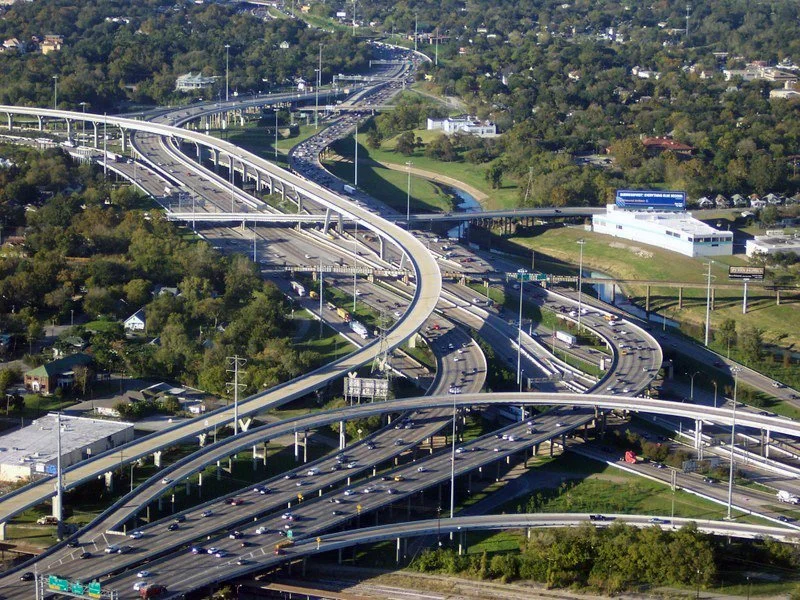As the Texas Department of Transportation (TxDOT) pushes forward with a controversial highway expansion, displaced residents feel unsupported. “I really don’t know where I am gonna go. I’m lost and I’m confused. I’m lost,” said Kelly Village resident Termeria Bartley in a 2021 interview with the Houston Press.
Her home in Kelly Village, a housing complex operated by the Houston Housing Authority, joined the projected 344 businesses, five churches, 160 single-family homes, 433 multi-family residential apartment units and an additional 486 “public and low-income housing” slated for destruction to make way for the expansion of Interstate 45, part of the North Houston Highway Improvement Project (NHHIP).
“It seems to be racial tradition in my community. TxDOT did this before,” remarked Kendra London, who grew up in the historically Black Fifth Ward, which houses Kelly Village. London’s grandmother, Ella Morris, remembers how construction of Interstate 10 damaged the Fifth Ward during the 1960s. “Once surrounded by homes, the residents of Kelly Village now lived at the confluence of—almost underneath—two major highways,” wrote LaRence Snowden, Chairman of the Board of Commissioners for the Houston Housing Authority about the consequences of the initial highway construction.
In addition to further bisecting the Fifth Ward, TxDOT’s plans for the NHHIP reshape Houston’s downtown. Strong Towns already reported on the wrecking ball that came for one of three buildings that make up the Lofts at the Ballpark, a 375-unit apartment complex. To many, The Lofts symbolized a positive shift for Houston, making their loss especially worrisome. “They served as an example of good urban planning: multi-family, connected to light rail, and located within walking distance of a revitalized entertainment district,” said Michael Moritz, a community organizer with Stop TxDOT I-45.
Steps from The Lofts stands an HHA complex similar to Kelly Village likewise awaiting demolition: Clayton Homes. They made news in 2017 when Hurricane Harvey flooded 112 of its units, displacing hundreds of residents and leaving those who remained to battle festering bacteria. A 2017 New York Times investigation found that the levels of E. coli in the Clayton Homes were 135 times higher than levels considered safe, and markedly higher than other neighborhoods likewise impacted by Harvey. With talks about the NHHIP already underway, the remaining residents spent the years following Harvey in substandard conditions. “They knew the highway was coming, so they didn’t care,” remarked one former resident.
In 2018, when Jasmine Gaston moved in, she recalls being warned, “Be prepared to leave. Don’t get comfortable.” For years, she and her kids went through each day uncertain whether their home would be leveled by the NHHIP the next. Through her window she could see homes made uninhabitable by Harvey degrade with each passing day. By 2021, relocation, or displacement, seemed imminent and with it, promises of higher quality accommodations. However, Gaston–who is intimate with the bureaucracy of public housing–was developing suspicions regarding those promises.
She recalls residents of Clayton Homes being offered Housing Choice Vouchers for which, under normal circumstances, they wouldn’t qualify. Even if the vouchers—for which eligibility is more exclusive—were granted, maintaining payments could put already displaced residents on the fastrack to homelessness. “Giving vouchers that are complicated and misleading without offering support is not good enough, it’s predatory to say the least,” she testified in a 2022 TxDOT Commission Meeting.
Gaston pointed out another guarantee that never materialized: replacement housing in the vicinity of Clayton Homes. “The HHA plans to build new subsidized housing in the general area of the existing facilities and has identified potential properties so that residents can move before their homes are affected by project construction,” reads the NHHIP project page, citing an initiative outlined in a Memorandum of Understanding (MOU) between TxDOT and the City of Houston.
“Nobody is in proximity to Clayton Homes anymore,” Gaston revealed, referring to all the residents who were forced to relocate as replacement housing was never constructed. She currently lives on the periphery of the city. One of her children is enrolled in a Magnet High School which would be a short train ride from Clayton Homes, but instead involves over an hour of sitting in Houston traffic.
In its Environmental Impact Statement, TxDOT admits that the project would “result in impacts to low-income and minority populations.” However, in that same document the agency maintains its peripheral projects–such as “improved pedestrian and bicycle accommodations” and “new facilities” will offset those adverse impacts. Gaston doesn’t buy it.
In a letter to the editor, she joined Joetta Stevenson, president of Super Neighborhood 55 in writing: “Deserved reparations and improvements should not be bound to a project that will cause even more harm and continue I-45’s legacy of environmental racism. We are not just opponents of a bad project, we are community members who believe better is possible and well-deserved.”
Those who aren’t directly threatened with displacement fear the impact of increased pollution. A 2019 Health Assessment Impact by Air Alliance Houston observed that hundreds of existing schools, daycares, homes, and workplaces will find themselves much closer to the highway, subjecting Houstonians to worse air quality, noise pollution, heat island effects, and increased flooding risks.
Houston is already considered one of the most ozone-polluted cities in the U.S. and the report asserts that the impact of increased pollutants would be felt most acutely amongst the lower-income, non-White communities located in the periphery of the expansion. Air Alliance also warns that in addition to the overwhelmingly negative environmental impact, the NHHIP would behave as a physical barrier, segregating communities on racial lines and in some instances, inhibiting convenient access to food and recreation.
Above all, critics of the NHHIP see trading thousands of homes, businesses, and livelihoods for a forecasted fewer minutes of travel time as fundamentally unjust. In an op-ed for the Houston Chronicle, Jeff Speck, author of Walkable City, calculated that together these residential, business, and community losses are predicted to cost Houston about $135 million in forgone city, property, and sales taxes each year. Robert Bullard, a professor of urban planning and environmental policy at Texas Southern University in Houston, feels that the NHHIP “joins a long history of infrastructure projects that have depreciated wealth in minority neighborhoods through the loss of homes and businesses.”
Displaced residents shouldering the costs of relocation, added distances between work, school, and home, as well as the pain of being uprooted from their communities agree: “How are we supposed to build ourselves up?” Jasmine Gaston wonders.


.webp)


